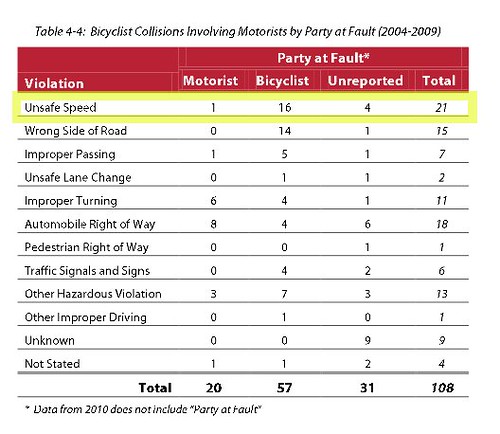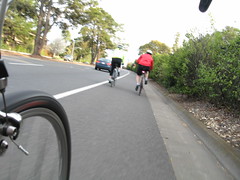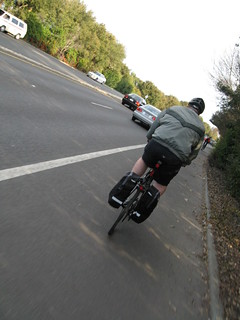(File under rabble rousing.)
My friend Ladyfleur looked at the new bike plan prepared by Alta Planning for the city of Los Altos, California and found something really alarming on Page 66 of the bike plan.
Do you see what I see?

Of 77 collisions where police identified fault, 57 of them — or fully 74% — were caused by the cyclist. Compare to the entire Bay Area, where police reports show cyclists are supposedly responsible for 60% of accidents.
It gets even sillier when you look at the most common violation: “unsafe speed.” While 28% of cyclists were found to be riding at an “unsafe speed” when they caused the wreck, only a single motorist from 2004 to 2009 was driving at an unsafe speed when he struck a cyclist.
How ridiculous is that?

Alta Planning’s only commentary in the bike plan is a dry suggestion for enforcement: “The most common bicycle violations were riding at unsafe speeds and riding on the wrong side of the road. Unsafe speed violations indicate the need for additional enforcement.” Yes, really: we have “bike advocates” and people who specialize in bike promotion blaming the victim here in California. These same inept clowns also proposed a 10 MPH speed limit on the Golden Gate Bridge for “safety,” although they reported no real safety issue on the bridge for cyclists.
The report shows most collisions in Los Altos occur on Foothill Expressway, with real hotspots on Foothill at each of Homestead, Fremont Avenue / Miramonte, and Springer Road. A third of reported collisions occurred at these three intersections.
I guess I can kind of see how a cyclist zooming downhill in the bike lane on San Antonio Road might get cited for violating California’s Basic Speed Law after he gets hooked. It’s not right, but I can kind of see the thought process.
But Foothill Expressway? That’s a county expressway with few intersections, no driveways, and a 45 MPH speed limit. It’s a favorite for local road cyclists because most of this expressway has wide, smooth shoulders and few lights. I average 24 MPH when riding through Los Altos; other cyclists get well up in the high 20s. They’re hauling. But that’s still far short of the 45 MPH speed limit; the 85th %tile speed likely approaches 55 MPH between Homestead Avenue and El Monte Road.
Initial police reports and at-fault statistics.

Collision statistics like this come from the California Statewide Integrated Traffic Records System” (SWITRS). SWITRS contains good information, but the ‘at-fault’ determination comes from the initial police report, which is just a guess. Actual liability is determined later, either through an insurance settlement or a formal investigation, if it even gets that far.
The “at-fault” statistics are thus faulty. This is why you won’t see me link to those silly Bay Area bike accident maps, because the information isn’t worth anything. You’d think Alta would at least know to footnote that kind of data.
Bike lawyer Bob Mionske has mentioned police bias several times in his columns, interviews and blog posts. A cycling attorney in Ohio, Steve Magas, believes he finds a pattern of police bias in accident reports in his state. He analyzed the data of 12,000 police reports from 2011 in his state and noticed an interesting anomaly: While police reports in many Ohio counties report cyclists at fault in about 50% of collisions (matching what we see statewide here in California), officers in Montgomery County Ohio report cylists at fault in 71% of cases.
I realize I’m a little unfair putting all of the blame on the Los Altos Police Department. Traffic collisions can be investigated by the California Highway Patrol, the Santa Clara Sheriff or the local police. Since cyclists cross city lines with ease throughout the Bay Area, though, why would the incidence of cyclists at fault be so much higher in Los Altos than elsewhere?
(I have inquiries in to the Los Altos BPAC about this for their thoughts and opinions. If I hear back from them I’ll update this post.)
I think an explanation from the police as to typical examples of “unsafe speed” might be of interest here. For instance, would blowing through a stop sign be considered “unsafe speed” (since the presumably safe speed would have been lower had the bicyclist stopped fully)? And given the likelihood that many of these accidents were on Foothill, a county road, who typically filed these reports – LAPD or the County? I’m not looking to excuse any possible bias here, just suggesting some additional information which might help shed more light on the reasons behind the statistics.
I recall reading a newspaper report recently saying that “unsafe speed” by bicyclists was also a leading cause of collisions in San Francisco, according to SFPD data. I think the explanation that the newspaper gave it that “unsafe speed” is a catchall category when the police don’t want to cite the car driver and there is an injury so they have to report something.
My guess would be that assertion by the police would probably be used for right hook crashes, where the cyclist was traveling straight and fast (25 mph +) in the bike lane and got trapped by a right hand turning motorist. Since the motorist would have passed the cyclists and then started the turn, the police would cite the cyclist for ‘running into’ the motorist even though it’s the responsibility of the motorist to slow and execute a safe right turn after the cyclist cleared the intersection.
But, these reports usually get written while cyclists are getting taken to the hospital in an ambulance and motorists would tell the police that they never even saw the cyclist that ran into them – hence ‘unsafe speed’ in the report.
Stop sign and red light violations would be “traffic signal and signs” violations, not unsafe speed. Looks like there were 7 bicycle violations in that category that led to collisions with motorists in the chart’s 5 year period.
I saw the San Francisco report too. That’s how I originally got riled up about the whole “unsafe speed” issue. But I don’t think it’s a catchall per se. In the Los Altos chart you’ll see there’s a “other unsafe driving” category that should be the catchall.
I think the issue is that cyclists are often going faster than drivers and police expect (or think they should be). Typical cases include (1) driver turns left in front of cyclist coming down a hill at > 15 mph (2) driver crossing road sees traffic stopped in the traffic lanes and proceeds without checking the bike lane.
I think that the bias actually lies more in the way the data was collected. If you are correct in assuming that the majority of the unsafe speed violations are fast cyclists getting right hooked (and I think you are) then you should group those numbers with the “improper turn” category, because that is probably where a right hook would be categorized if it were to be blamed on the car. That brings the ratio to about 65%, which is much closer to the statewide average.
The last thing I want to be is an apologist for police or drivers, so I gotta say that its obvious there is a bias here, just maybe not as profound as the numbers initially indicate.
Wait, no, my math is horrible. Still skewed. But still, I think that the improper turns should be grouped with the unsafe speed violations if were talking right hooks.
I’d also look askance at the “Improper Passing” numbers. I got right hooked a couple years ago, and the cops decided that I was passing on the right for their report. Thankfully, I had helmet-cam footage to prove my case when the driver’s insurance company came after me.
I agree that there certainly is some anti-bike bias out there. The one that gets me most is the data that suggests that the person who lives is unlikely to be considered at fault.
However, I think the post by Mr. Masoner is fundamentally wrong. I read relevant parts of the report here: http://www.ci.los-altos.ca.us/committees-commissions/bpac/pdf/2012%20Los%20Altos%20Bicycle%20Transportation%20Plan.pdf
Here’s why I think Mr. Masoner’s post is flawed:
1) Most of these collisions during the 5 year period are _not_ on/along Foothill. Yes, the specific locations with the most collisions are on Foothill (4 locations), but 76 of the 108 collisions are (presumably) _not_ on Foothill. There are a lot of other “locations” in Los Altos (an infinite number, obviously. 🙂 )
2) Only the “unsafe speed” listing shows a likelihood of bias. However, we don’t know if _any_ of those citations were given at the Foothill locations. We have to assume that some were.
3) “Unsafe speed” can also mean going too slowly in a blind curve, etc., not just going too fast. Again, we don’t know where these citations were given. This also includes pulling into a car lane to pass another cyclist and not getting out of the way fast enough. The car has right-of-way in its own lane, within reason, if someone suddenly pulls out in front of them. I see a lot of this when a pack of cyclists pulls away from a stop light. I also suspect that this is a blanket category for occasions when “unsafe speed” is a catch-all for some of the other categories.
4) 14 citations are for going the wrong way (and that’s one of those violations that just isn’t up for interpretation) also indicates that there are a lot of stupid cyclists out there. When is the last time you saw a car going the wrong way down the street?
5) I hope everyone here has a better grasp of statistics than Mr. Masoner. There aren’t enough data points here to actually claim certain bias (particularly if you consider that the “unsafe speed” category averages out to about 3 citations a year vs. whatever the rate is annually for the whole Bay Area).
6) The overall plan, besides being a method for bureaucrats to further their own employment, is also a real attempt to improve cycling safety in Los Altos. Take a look at Sections 5.6.2, 5.6.3, and 5.6.4. Slamming the whole city at the very moment that they’re trying to do some good is just plain foolish.
7) If cyclists obeyed the law a bit more strenuously (and this goes to the whole “I don’t worry about this stuff because _I_ actually stop at stop signs” discussion), then we’d have the moral high ground. We don’t. As a group, we break the law more often. Once that changes, we’ve earned the right to whine about police bias.
You want to go to the heart of the bias claim? People. They choose to drive 3000lb cars way too often and it gives them the upper hand against those that don’t. We get hurt and have a lot of fear of getting hit. Unbiased physics, unfortunately, works against cyclists.
Pax,
Pete
Thanks for the love! One quick correction – I have not yet looked at 12,000 reports – I have them – but, sadly, I also have a real job…. however, I DID look at the county breakdowns for several of Ohio’s bigger counties… and the Montgomery County [Dayton, Ohio] figures struck me as being out of whack – they ride a lot in Dayton – could those riders be so much more careless as to cause 70% of all the car/bike crashes? Doesn’t make too much sense….